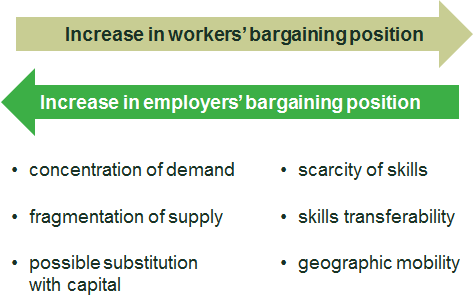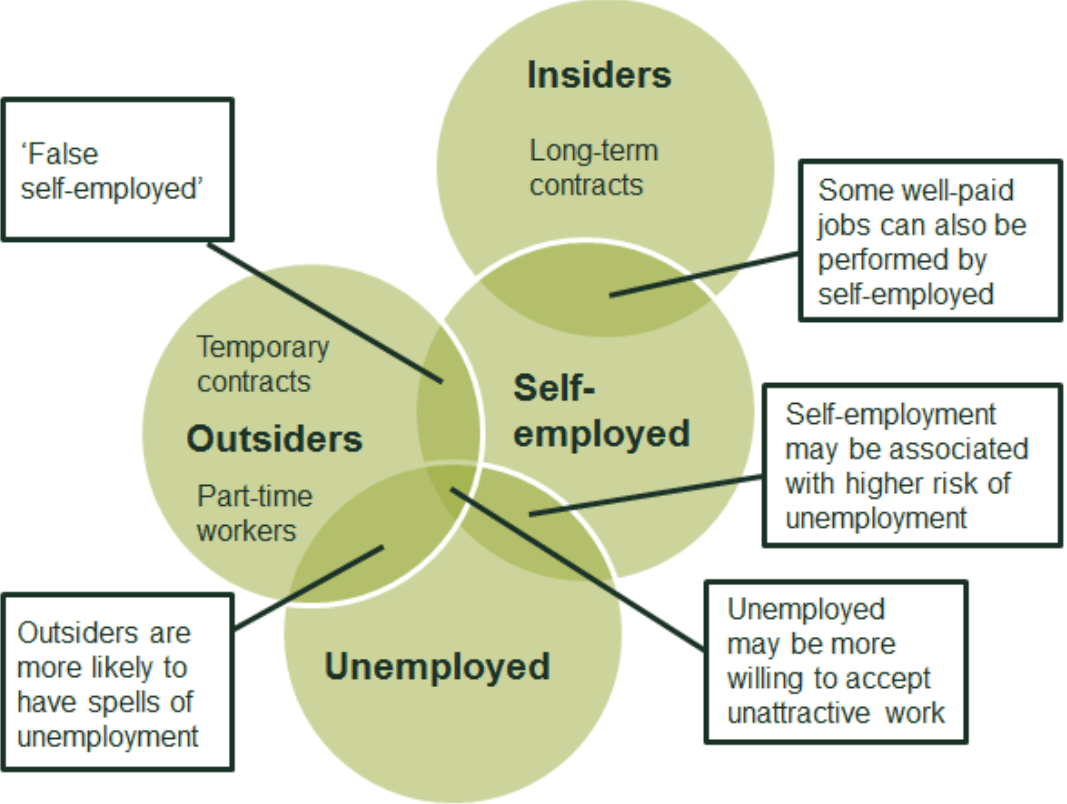How do non-poaching agreements distort competition?
Agreements between firms not to hire each other’s workers have recently come onto the radar of competition authorities, particularly in the USA. However, there is a question about whether labour markets come within the remit of competition authorities, and whether it is their role to intervene. If it is, how can tools developed in competition economics help in such cases?
The role of competition policy in society has recently come under scrutiny. A particularly controversial topic among economists and policymakers is whether competition authorities should concern themselves with labour markets. The chair of the US Federal Trade Commission, Joseph Simons, elaborates:1
Significant concerns have been raised that the federal antitrust agencies have been too permissive in dealing with mergers and acquisitions, resulting in harm to consumer welfare via increased prices, limited consumer choice, and harm to workers. Addressing these harms is critical, as they lie at the heart of the agency’s competition mission.
Oxera’s Economics Council met to discuss this topic in May 2019. This article is the first of two that will present insights from the discussions that took place during that meeting.2
In this article, we first discuss non-poaching agreements and recent cases, particularly in the USA. Since these cases involve market power on the demand side of the market (e.g. firms as the purchasers of labour) and, unlike traditional antitrust cases, do not involve harm to consumers directly, they are rarely investigated by competition authorities. We then discuss how, from an economics perspective, non-poaching agreements may harm competition in the labour market and may be as harmful as some more traditional agreements that are on the supply side of markets.
Non-poaching agreements: definitions and recent developments
Non-poaching agreements refer to action taken by two or more firms to coordinate their hiring and pay and benefits policies. Workers are unaware of these agreements and are therefore not in a position to negotiate any additional compensation associated with them. The aim of the agreements is to reduce personnel expenditure, thereby potentially increasing profits. They relate to firms in a labour market—i.e. to the demand side of that market.
The workers’ lack of awareness about these agreements is in contrast to other forms of agreement in the labour market, such as non-compete clauses—whereby a worker agrees to temporarily give up their right to work for a competitor of their employer. There are often efficiency reasons for the existence of non-compete clauses, such as the preservation of human capital investment or trade secrets. The principal difference between non-compete clauses and non-poaching agreements is that workers are required to agree to a non-compete clause, giving them the opportunity to negotiate the terms; no such opportunity exists with non-poaching agreements.
Firms are typically considered as ‘buyers’ of labour, and workers as ‘suppliers’. Non-poaching agreements allow several firms to coordinate their purchase of labour, with the aim of increasing their buyer power and thus decreasing their labour costs. By agreeing not to compete for certain groups of workers, these agreements can be thought of as similar to horizontal market allocation.3 The US Department of Justice (DoJ) has recently indicated that it will actively pursue investigations into non-poaching and wage-fixing agreements between employers. The DoJ elaborated:4
When companies agree not to hire or recruit one another’s employees, they are agreeing not to compete for those employees’ labor. The same rules apply when employers compete for talent in labor markets as when they compete to sell goods and services. After all, workers, like consumers, are entitled to the benefits of a competitive market.
The first notable case was a class action lawsuit brought by the DoJ in 2010, following reports that eight hi-tech firms in the USA had allegedly entered into ‘no cold call’ agreements for technical professionals, such as software and hardware engineers.5 Cold calls have the direct effect of giving workers bargaining power to renegotiate their current contracts, or to switch to another position with potentially better pay. They also have the indirect effect of revealing to workers their worth in the labour market, which could then be used in negotiations. In the 2010 case, the alleged non-poaching agreement weakened the ability of the software and hardware engineers to claim higher wages. The case was settled in 2015, following a $415m payment to the workers in the class action.6
In April 2018, a civil antitrust lawsuit was settled with the DoJ in a ‘naked’ non-poaching case—i.e. where the non-poaching agreements had no objective rationale, such as fostering business collaboration. The two main US rail equipment suppliers, Knorr-Bremse and Westinghouse Air Brake Technologies, had allegedly agreed not to hire each other’s workers without each other’s prior approval.7 This alleged agreement, spanning multiple business units and jurisdictions, was said to have lasted for several years. Senior executives were alleged to have actively managed it through communication. The DoJ argued that not only were the two firms each other’s top competitors in the rail equipment market, but they also competed:8
[…] to attract, hire, and retain skilled employees by offering attractive salaries, benefits, training, advancement opportunities, and other favorable terms of employment.
Such cases are far less common in Europe, but it is generally assumed that labour markets fall within the realm of EU competition law.9 Therefore, those engaging in anticompetitive behaviour in labour markets, such as non-poaching agreements or information sharing, may face prosecution from national or supranational competition authorities. However, and contrary to what has been seen in the USA, the cases seen in Europe have been linked to other investigations, with labour markets being a secondary concern. For example, in France, in an investigation relating to the conduct of agencies in the product market, the French Competition Council acknowledged that the labour market was also affected, as the agreement increased the cost to companies of hiring temporary staff. This resulted in the temporary staffing agencies being fined €94m in 2009 for coordinating their commercial and pricing policies for ‘key accounts’.10
Should competition authorities intervene in non-poaching agreements?
This recent surge of concerns about the labour market, especially in the USA, might surprise competition law professionals. The current standard view is that competition policy should focus on the defence of consumer outcomes in the product markets.11 Its role is to ensure that prices, quantities sold and quality are as close as possible to the competitive benchmark. Under a strict application of such standards, ensuring fair wages and working conditions is not part of the objectives of competition authorities.
Investigating concentration on the demand side of the labour market might therefore appear at odds with the traditional role of competition authorities. Indeed, non-poaching agreements allow firms to reduce their costs by reducing their personnel expenditure, and they may pass this cost reduction on to end-consumers.
This argument is often developed in the context of ‘group purchasing’ agreements, where firms coordinate their purchase of an input in order to decrease their input costs and trigger efficiencies (e.g. increasing returns to scale from larger purchases). Group purchasing is also seen as a way for retailers to offset market power from large producers.
In other words, buyer power is sometimes perceived as beneficial to consumers and is not always investigated by competition authorities. They typically apply a ‘rule of reason’, where the pros and cons of buyer power are weighed against each other. In a landmark judgment in the USA, the Supreme Court stated that a buying group is:12
[…] designed to increase economic efficiency and render markets more, rather than less, competitive […].
One might therefore ask whether actual harm arises from non-poaching agreements.
In addition, workers are protected by employment laws, which may ensure a minimum wage, limited working hours, and specific rules on working conditions.13 In economics terms, labour law favours supplier (i.e. employee) market power in this specific context, which would limit the ability of employers to exercise market power. Labour unions are a central part of such a scheme.14
Nonetheless, competition economics has a role to play in the analysis of labour markets. This remains true even if competition policy does not deal with the social dimension of labour markets (i.e. with the fact that higher wages and better working conditions may be seen by some as legitimate objectives in their own right, regardless of economic efficiency).
Why non-poaching agreements may harm competition in the labour market
In any market, the relationship between supply and demand determines the price, output level and quality of the product sold. In the labour market, individual workers and individual firms often coordinate through a bargaining process. The economics of bargaining teaches us that the value obtained by the different parties in a negotiation depends on their outside options. In the context of wage bargaining, the outside options available to workers are other potential employers that may offer higher wages or better working conditions. On the other side of the market, employers have the outside option of hiring other workers who may be willing to accept lower wages. Figure 1 depicts factors affecting these outside options.
Figure 1 Factors affecting the wage bargaining process between workers and employers

At the market level, these outside options in the bargaining problem shape supply and demand, and consequently wages and employment levels.15 In perfectly competitive labour markets there are many workers on the supply side and many firms on the demand side, and neither side has strong relative bargaining power. In this setting (without other complications), wages are competitive and workers can expect a wage that represents their incremental value creation.16
When one of the two sides of the market gains stronger bargaining power, wages deviate from a competitive equilibrium and the ‘stronger’ side of the market extracts a ‘rent’ from the other. In other words, when workers have a stronger bargaining power than firms, wages tend to be inflated relative to a competitive benchmark. By contrast, when firms have relatively strong bargaining power, wages tend to be deflated.
Non-poaching agreements aim to shift the balance of power in the bargaining process in favour of employers. By refusing to hire each other’s workers, firms reduce the set of potential employers available to workers. Similar to what is observed with group input purchasing, non-poaching agreements may benefit consumers, who would enjoy lower prices. However, in the case of non-poaching agreements, lower prices come at the expense of employees, who earn lower wages.
However, non-poaching agreements differ from group input purchasing in an important way—when firms enter into a non-poaching agreement, it does not mean that they agree to purchase labour as a group to offset supplier market power. Instead, firms secretly agree to shift the balance in the bargaining process, by agreeing not to compete for certain employees. By contrast, group input purchasing aims to secure better terms of supply than what may be offered by a relatively strong seller (e.g. a globally recognised manufacturing brand), which might generate efficiencies.
Contrary to the efficiency rationale for group input purchasing and non-compete clauses, non-poaching agreements may sometimes be used not to offset seller power or trigger efficiencies, but rather to simply increase firms’ profits at the expense of other market participants.
Similarly, while labour law may foster seller market power, it does not apply to all workers. Indeed, there are different types of contract that offer different degrees of protection to workers, as illustrated in Figure 2.
Figure 2 A typology of the supply side of the labour market

For example, employees on temporary contracts often have weaker bargaining power than permanent staff, as they are not unionised or part of any collective agreements. A 2015 European Commission study found that the same individual doing the same job on average earns 15% more with a long-term contract than with a fixed-term contract.17 Similarly, contractors have lower job security and are generally paid less than in-house workers.18
Therefore, as many workers are not covered by labour law, it may not be the most appropriate tool to deal with competition concerns in the labour market.
Conclusion
Concentration on the demand side of the labour market does not fall within the traditional focus of competition policy. However, as explained above, non-poaching agreements may indeed harm competition in the labour market. In the USA, this harm has been at the heart of some recent cases; in Europe, it is not yet clear whether competition authorities will investigate such cases or whether labour market concerns will continue to be secondary to product market investigations.
Besides non-poaching agreements, non-compete clauses have come under scrutiny. As discussed in this article, non-compete clauses require workers to commit not to work for the competitor of their former employer for a certain period of time following the end of their contract. In terms of competition economics, these clauses are similar to exclusive dealing agreements, whereby a firm commits to trade exclusively with a supplier for a certain period.
Similarly to exclusive dealing, in some cases there may be good reasons to have non-compete clauses as part of a contract. They are used to solve the ‘hold-up’ problem—whereby, for example, a worker may walk away with trade secrets. Yet they also have the potential to limit competition in the labour market by restricting alternative options for workers, and they are regulated in some countries.
Assessing whether such non-compete agreements are anticompetitive requires an understanding of the balance of power in the wage bargaining process, and to what extent one of the two parties can exploit the other. This merits its own discussion of the framework and principles to apply to such an analysis.
For non-poaching agreements, on the other hand, the competitive benefits seem to be relatively limited. Given the growth of non-poaching investigations in the USA, it may not be long before such cases also become a feature in Europe.
1 Guniganti, P. (2018), ‘FTC will look at labour monopsony, Hoffman says’, GCR, 8 June, accessed 5 June 2019.
2 The Oxera Economics Council is a group of prominent European thinkers and academics, specialising in microeconomics and industrial organisation, that meets with Oxera twice a year to discuss pressing economic issues facing policymakers. The most recent Oxera Economics Council meeting took place in Brussels on 14 May 2019, attended by Oxera consultants, the Council members, and guests from the European Commission and academia. This article is produced solely by Oxera, and does not necessarily represent the views of the Council members or the guest attendees.
3 Horizontal market allocation occurs when firms agree not to compete with each other in certain markets—for example, by allocating geographic areas, types of products or types of customers.
4 Department of Justice (2018), ‘Division Update Spring 2018’, accessed 5 June 2019.
5 Department of Justice (2010), ‘Case: 1:10-cv-01629’. ‘Cold calling’ refers to the practice of reaching out to professionals who did not apply for a position.
6 For example, see Levine, D. (2015), ‘U.S. judge approves $415 mln settlement in tech worker lawsuit’, Reuters, 3 September, accessed 5 June 2019.
7 Department of Justice (2018), ‘Case 1:18-cv-00747’.
8 Department of Justice (2018), ‘Case 1:18-cv-00747’, p. 4.
9 For example, see OECD (2019), ‘Competition Policy for Labour Markets – Note by Herbert Hovenkamp’, Roundtable on Competition Issues in Labour Markets, 17 May, accessed 18 June 2019.
10 Conseil de la concurrence (2009), ‘Décision n° 09-D-05 du 2 février 2009 relative à des pratiques mises en œuvre dans le secteur du travail temporaire’.
11 Aranze, J. (2019), ‘Getting on board – Siemens/Alstom’, GCR, 3 June. See also OECD (2019), ‘Competition Policy for Labour Markets – Note by Herbert Hovenkamp’, Roundtable on Competition Issues in Labour Markets, 17 May, accessed 18 June 2019.
12 United States Supreme Court (1985), ‘NORTHWEST STATIONERS v. PACIFIC STATIONERY(1985)’, Case No. 83-1368.
13 However, non-poaching agreements often cover skilled workers whose contract terms are already above the minimum standards set out in labour law.
14 Labour unions form the legal equivalent of a supplier-side collusive agreement, although unions are not undertakings as such and therefore do not fall directly under the same legal framework.
15 They determine the elasticity of supply and demand, which represents the sensitivity of each side of the market to a change in wages. Another feature of the labour market is that, contrary to other markets, the labour market usually does not clear, meaning that not all workers who want a job can get one.
16 More precisely, workers receive compensation that is equal to the value of their marginal output.
17 Da Silva, A.D. and Turrini, A. (2015), ‘Precarious and less well-paid? Wage differences between permanent and fixed-term contracts across the EU countries’, European Commission Economics Papers 544, February.
18 Berlinski, S. (2007), ‘Wages and Contracting Out: Does the Law of One Price Hold?’, British Journal of Industrial Relations, 46:1. Dube, A. and Kaplan, E. (2010), ‘Does Outsourcing Reduce Wages In The Low-Wage Service Occupations? Evidence From Janitors And Guards’, ILR Review, 63:2, pp. 287–306.
Download
Related

The 2023 annual law on the market and competition: new developments for motorway concessions in Italy
With the 2023 annual law on the market and competition (Legge annuale per il mercato e la concorrenza 2023), the Italian government introduced several innovations across various sectors, including motorway concessions. Specifically, as regards the latter, the provisions reflect the objectives of greater transparency and competition when awarding motorway concessions,… Read More

Switching tracks: the regulatory implications of Great British Railways—part 2
In this two-part series, we delve into the regulatory implications of rail reform. This reform will bring significant changes to the industry’s structure, including the nationalisation of private passenger train operations and the creation of Great British Railways (GBR)—a vertically integrated body that will manage both track and operations for… Read More

